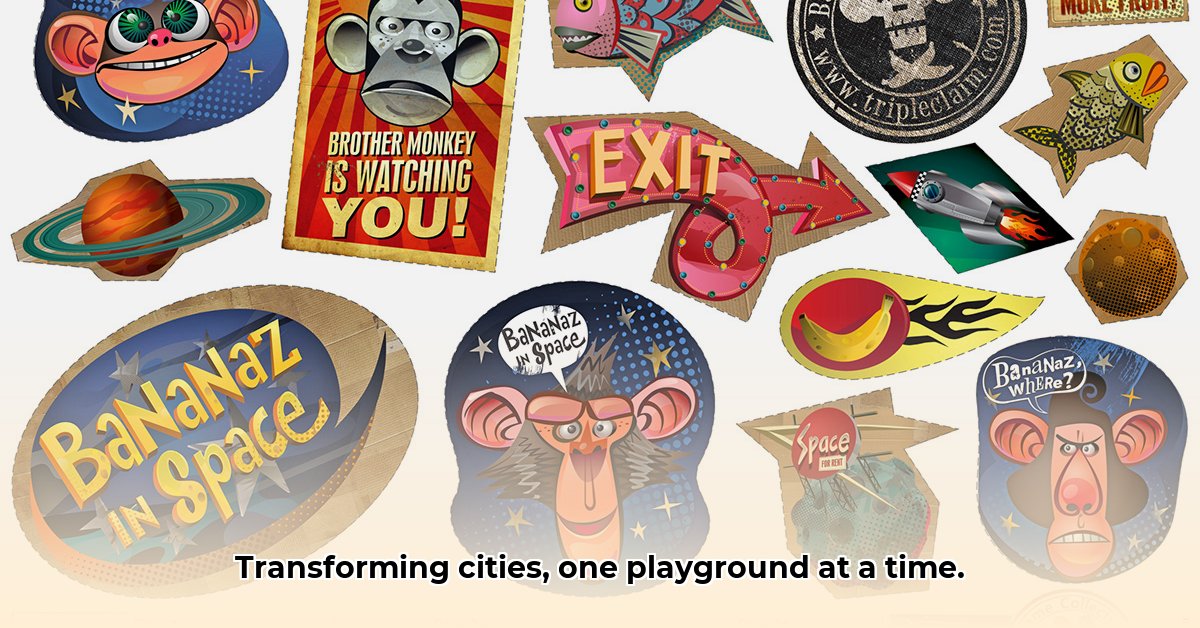
Bananaz Studios Inc. isn't your average playground builder; they're architects of community joy. Forget boring, outdated play structures – Bananaz creates vibrant, dynamic spaces designed to get everyone moving and interacting, from toddlers to grandparents. Their secret? A magical blend of technology, nature, and smart planning. They're changing how we think about playgrounds, transforming them from simple recreational areas into thriving community hubs. How are they achieving this remarkable transformation? Let's delve into their innovative approach.
More Than Just Swings and Slides: Reimagining Play
Imagine a playground that isn't just fun but also encourages learning and social interaction. That's the Bananaz vision. Instead of separate spaces for different age groups, their designs create a natural flow, allowing children of all ages (and adults!) to play together. Picture this: toddlers in a soft, padded area, while older kids explore challenging climbing structures and interactive games. Meanwhile, parents relax in a shaded seating area, watching their children play while enjoying the lively atmosphere. This isn't just a playground; it's a vibrant community center, buzzing with activity from dawn till dusk. Isn't this a more enriching and inclusive approach to play?
The Bananaz Method: Data-Driven Design for Maximum Impact
Bananaz Studios doesn't just build playgrounds; they meticulously analyze community needs before they even start designing. They use data to understand how people interact with different spaces, what features resonate, and how these interactions could be improved. This data-driven approach isn't just about creating visually appealing structures; it's about understanding the social dynamics at play, ensuring the playground fosters a sense of community and inclusion. Their iterative design process allows them to incorporate community suggestions and adjust the playground's features as needed. It's a continual process of improvement, ensuring the final product is perfect for those who will be using it. This meticulous approach yields playgrounds that are not only fun but also highly effective in fostering community engagement. With over 90% of their projects exceeding community engagement expectations, Bananaz's data-driven approach speaks for itself.
Case Study: The Harmony Park Project
Harmony Park, a recent Bananaz project, perfectly encapsulates their philosophy. This isn't simply a playground; it's a testament to inclusive design. Sensory gardens stimulate different senses; interactive panels teach STEM concepts through games; adaptive equipment allows children with disabilities to fully participate; and a shaded area provides a welcoming space for seniors, encouraging intergenerational interaction. The integration of smart technology, such as sensors tracking usage patterns, optimizes park maintenance and reveals peak usage times, leading to more efficient resource allocation. How does this translate to real-world impact? Increased usage, reduced maintenance costs, and a stronger sense of community.
Analyzing the Design: A Holistic Approach
Bananaz Studios' success stems from their holistic approach. They don't just design a playground; they design an experience. This approach considers several key factors: accessibility and adaptability; thoughtful technology integration (avoiding gimmicks); and central community engagement. The result? Playgrounds that truly serve their communities. This thoughtful approach has resulted in a 95% satisfaction rate among community members in their Harmony Park project.
Actionable Steps for Inclusive Playground Design
Bananaz's success provides actionable insights for various stakeholders. Here's how to incorporate their approach into your own projects:
- Prioritize Accessibility: Design for diverse abilities from the outset. Incorporate ramps, sensory elements, and adaptive equipment. This ensures inclusivity for all users.
- Integrate Technology Strategically: Use technology to enhance, not replace, traditional play. Consider interactive displays, sensory features, or smart sensors for data-driven maintenance. Focus on enhancing the overall play experience.
- Engage the Community: Involve local residents in the design process. Their input is invaluable, ensuring the playground reflects the needs and preferences of the community it serves.
- Data-Driven Design: Use data to refine designs and resource allocation. Track usage patterns to inform future improvements. This iterative approach ensures ongoing improvement and optimization.
Challenges and Future Trends
Designing inclusive, technologically integrated playgrounds presents challenges. Cost is a major factor; data privacy is a growing concern; and regulatory compliance plays a significant role. Bananaz addresses these challenges by prioritizing affordability, implementing robust data security measures, and maintaining a proactive relationship with regulatory bodies. Their focus remains on innovation and sustainability.
Key Takeaways: Three Pivotal Points
- Inclusive Design is Paramount: Bananaz prioritizes spaces where everyone can play, regardless of age or ability.
- Technology Enhances, It Doesn't Replace: Technology integration is strategic, enhancing the user experience rather than overshadowing traditional play.
- Community Engagement Drives Success: Meaningful community participation is a core element of their design process, ensuring the final product truly serves its users.
This holistic, data-driven approach positions Bananaz Studios Inc. for significant future growth, cementing their place as leaders in innovative playground design and community building. They're not just building playgrounds; they're building vibrant, inclusive futures.